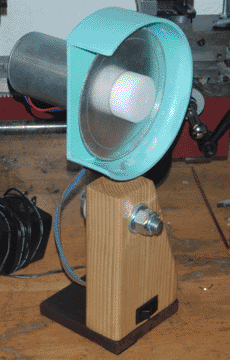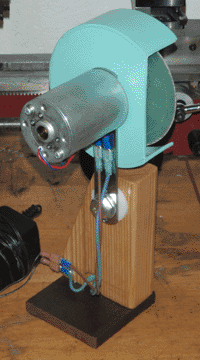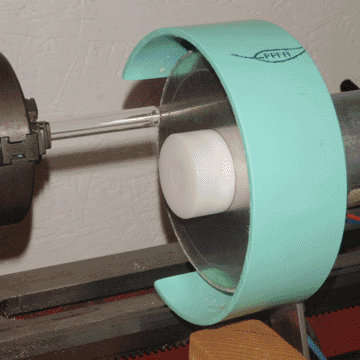


The diamond saw I made earlier worked well, but was difficult to use due to the fact that I had to balance it on the compound slide of my lathe. It also sprayed a slurry of water and glass dust everywhere when cutting, which often got into my eyes. To solve both of these issues and to make the saw more convenient overall, I designed a base, an arm, and a blade guard for it.
The base was made from a scrap piece of hot-rolled steel and a 2x4. The 2x4 has a pocket milled in it to house the power switch, and a one inch hole drilled through it, where a Delrin bushing fits. The wood was then coated with shellac and oil, which I find produces a superb finish with minimal time and effort. This also seals out any contaminants from the wood, which is important since it will be used in a fairly dirty environment. I often turn iron and graphite on my lathe, and the residue from either would quickly turn the wood black, were it left unfinished. Not shown above are four rubber feet on the steel base, which allow it to grip the table and maintain its position during a cut. They were cut from a bicycle inner tube and glued in place with rubber cement.
The arm is simply a piece of 1/8 inch thick steel bar, machined on one end to match the mounting holes on the motor, and with a half inch hole on the other end through which a long bolt fits. The smooth shaft of the bolt pivots in the delrin bushing, and the threads protrude from the other side and hold a lock-nut, which is used to adjust the friction of the pivot action.
Finally, the blade guard is made from PVC drain pipe, thermo-formed and solvent welded together with clear PVC cement. I have found this to be an excellent material in general; sections of large diameter pipe can be warmed with a heat gun and pressed flat between pieces of wood to make PVC sheet very cheaply, and solvent welding produces a strong joint if the surfaces are cleaned with acetone beforehand.
The saw performs excellently, and the blade guard is a massive improvement. It efficiently traps all of the glass slurry that would have ordinarly been flung upwards and backwards, and since it is made of PVC there is no danger of the moisture rusting it or otherwise causing damage. The saw cuts glass more cleanly than before as well; the heavy base makes it more stable, so there is less tendency for the blade to twist the glass and break it off prematurely. As before, the cutting action is still very efficient; the 10mm tubing in the picture above was parted off in less than a second.